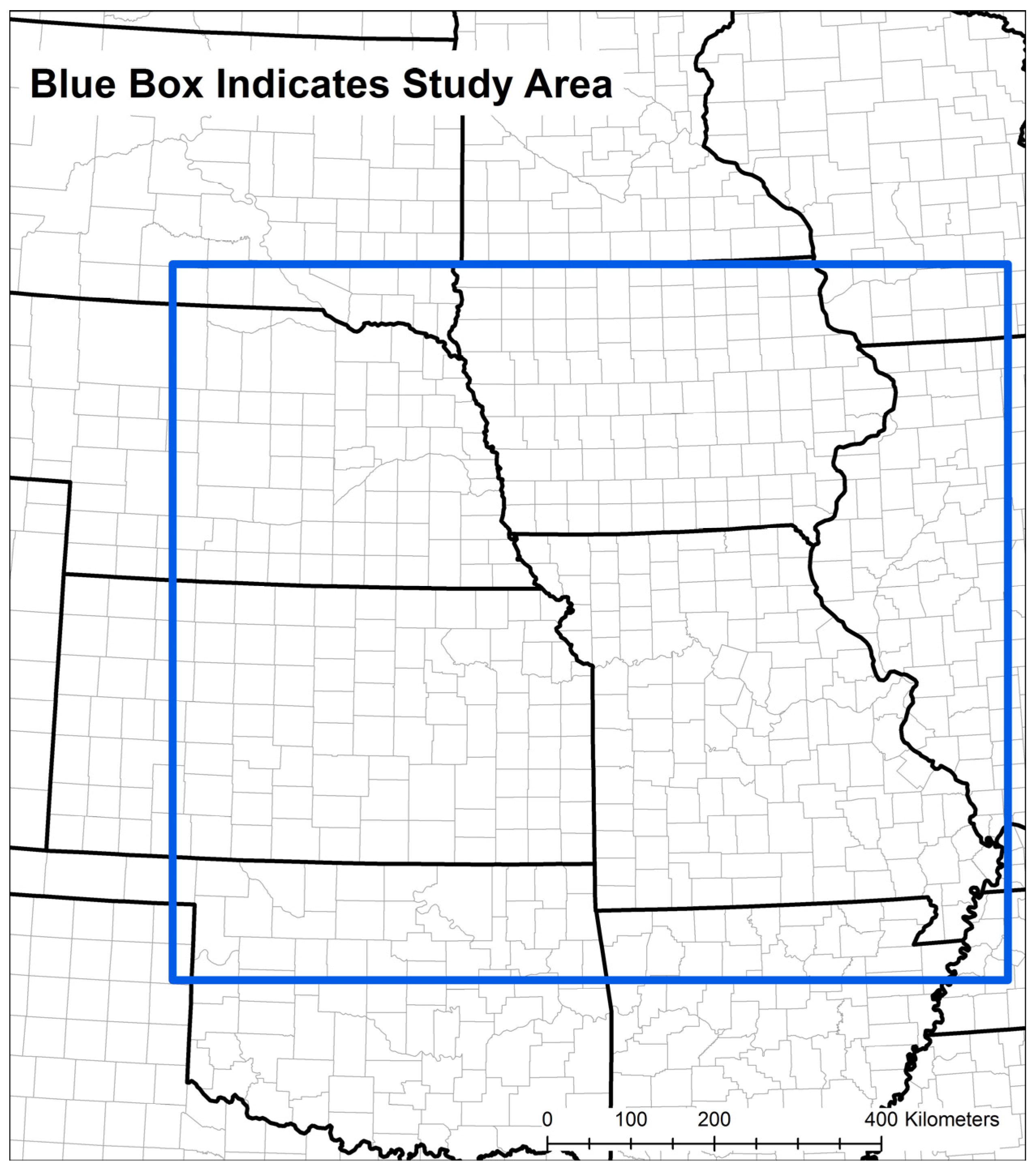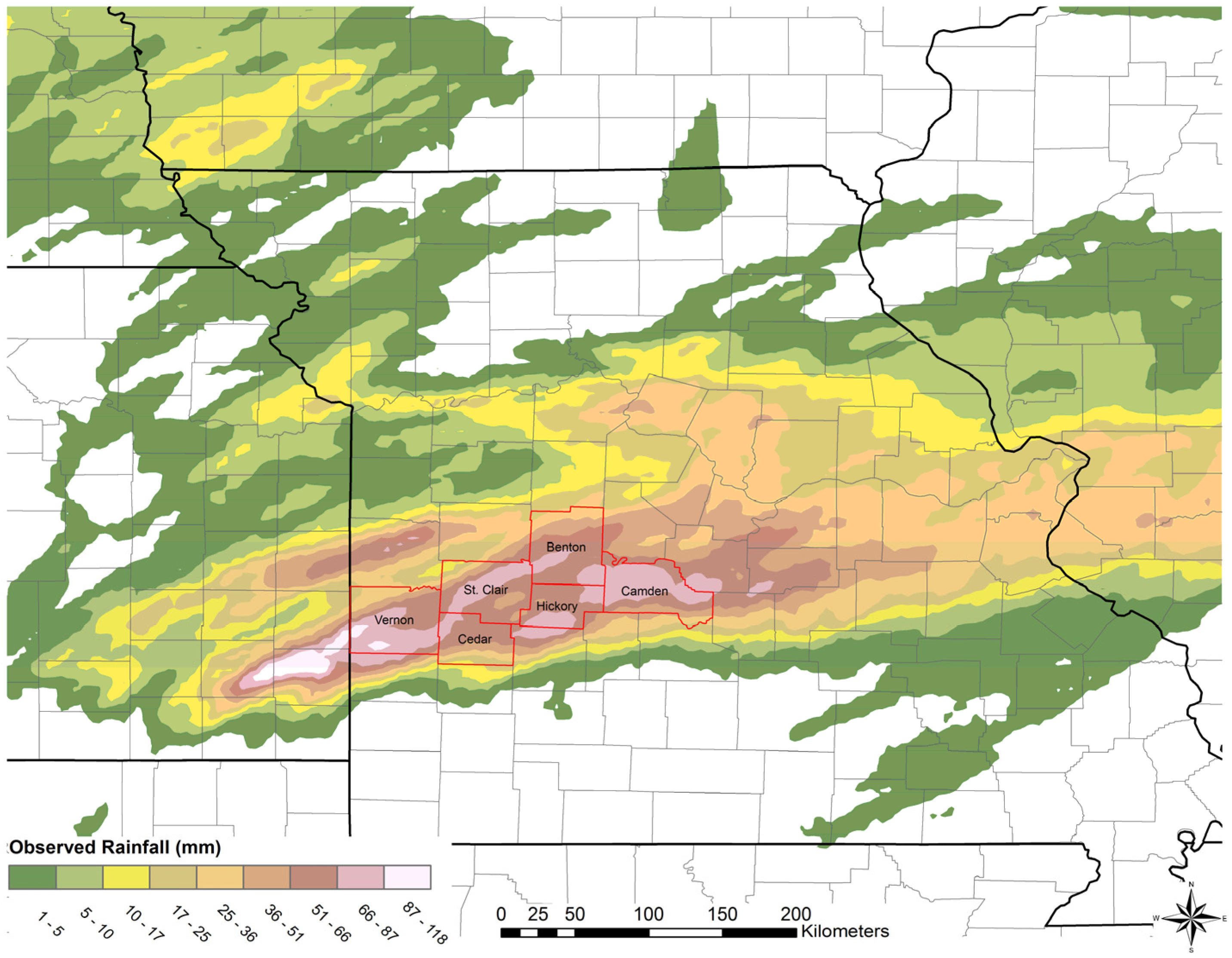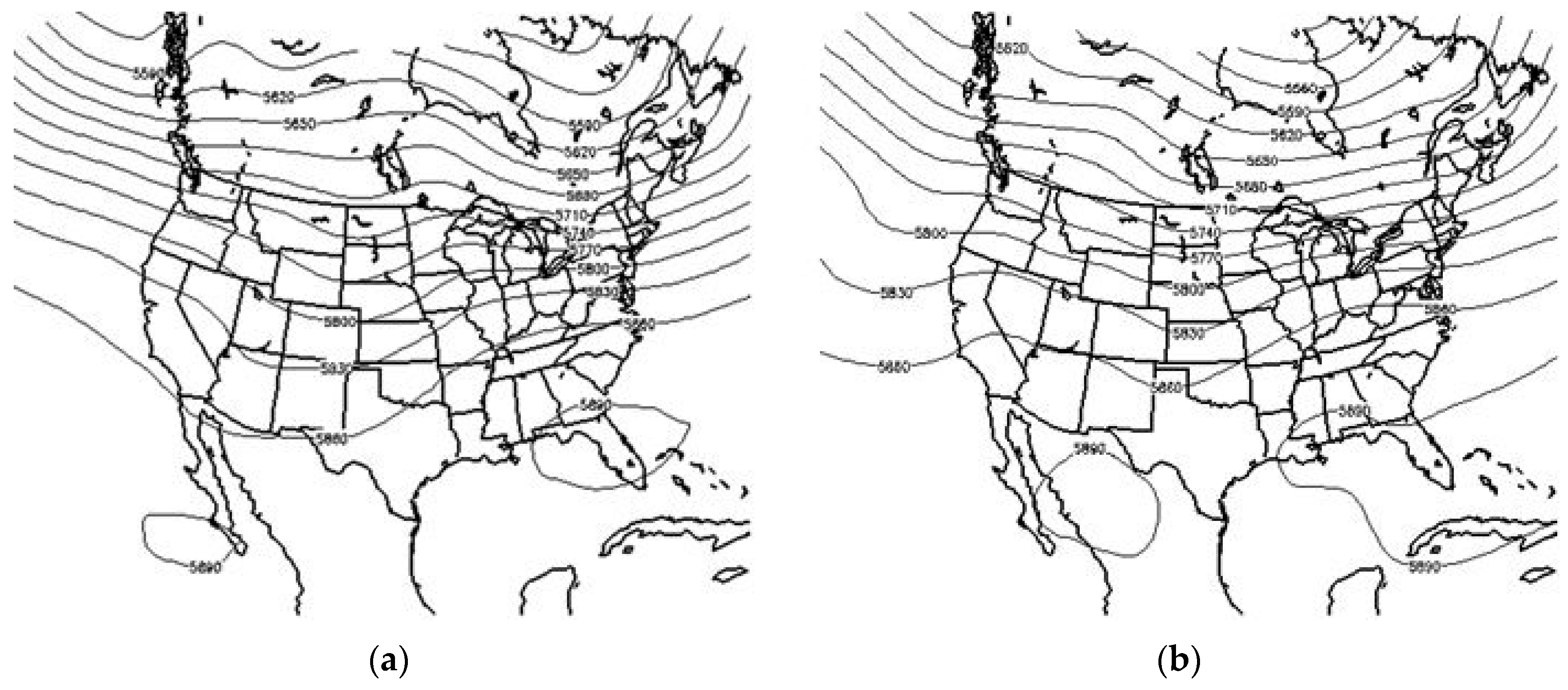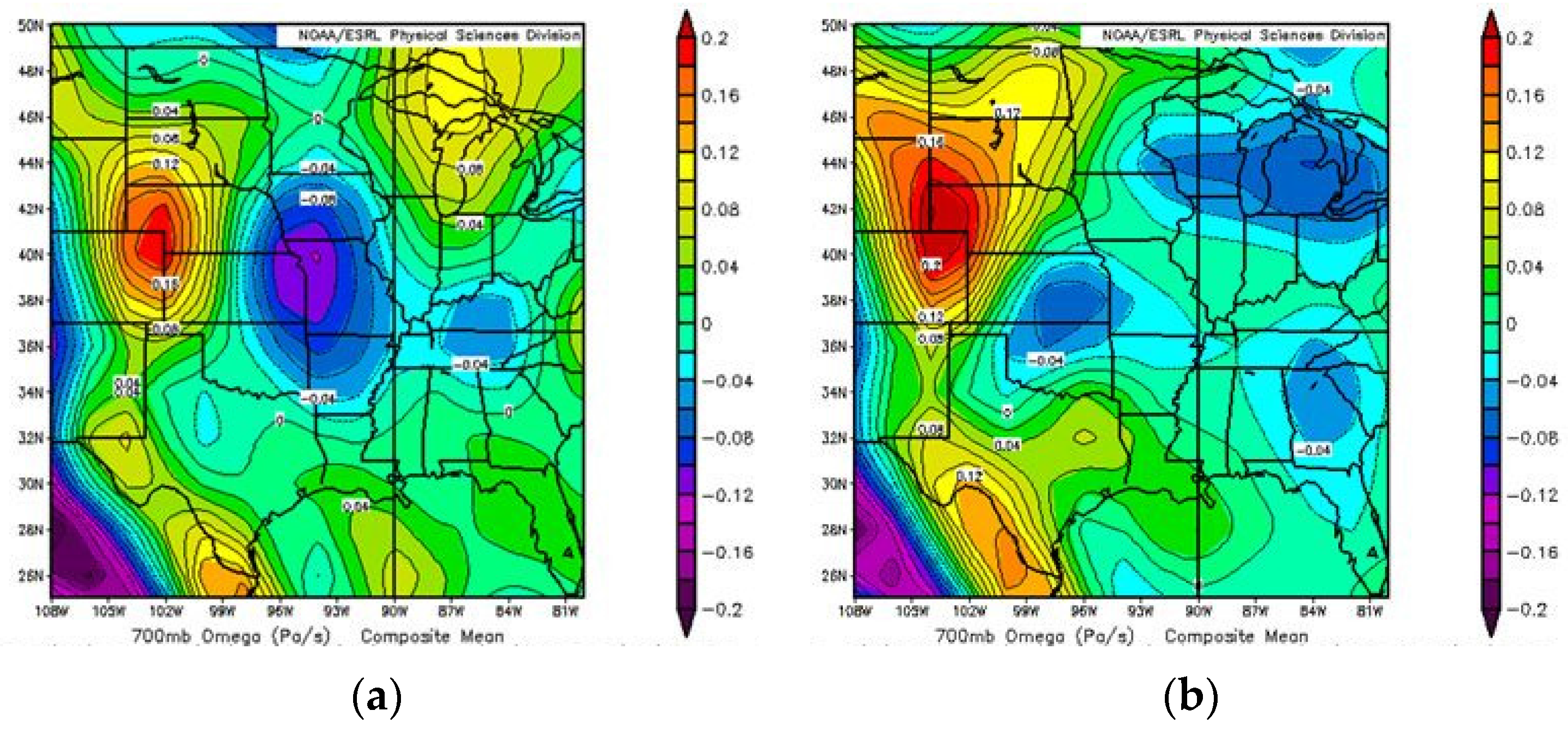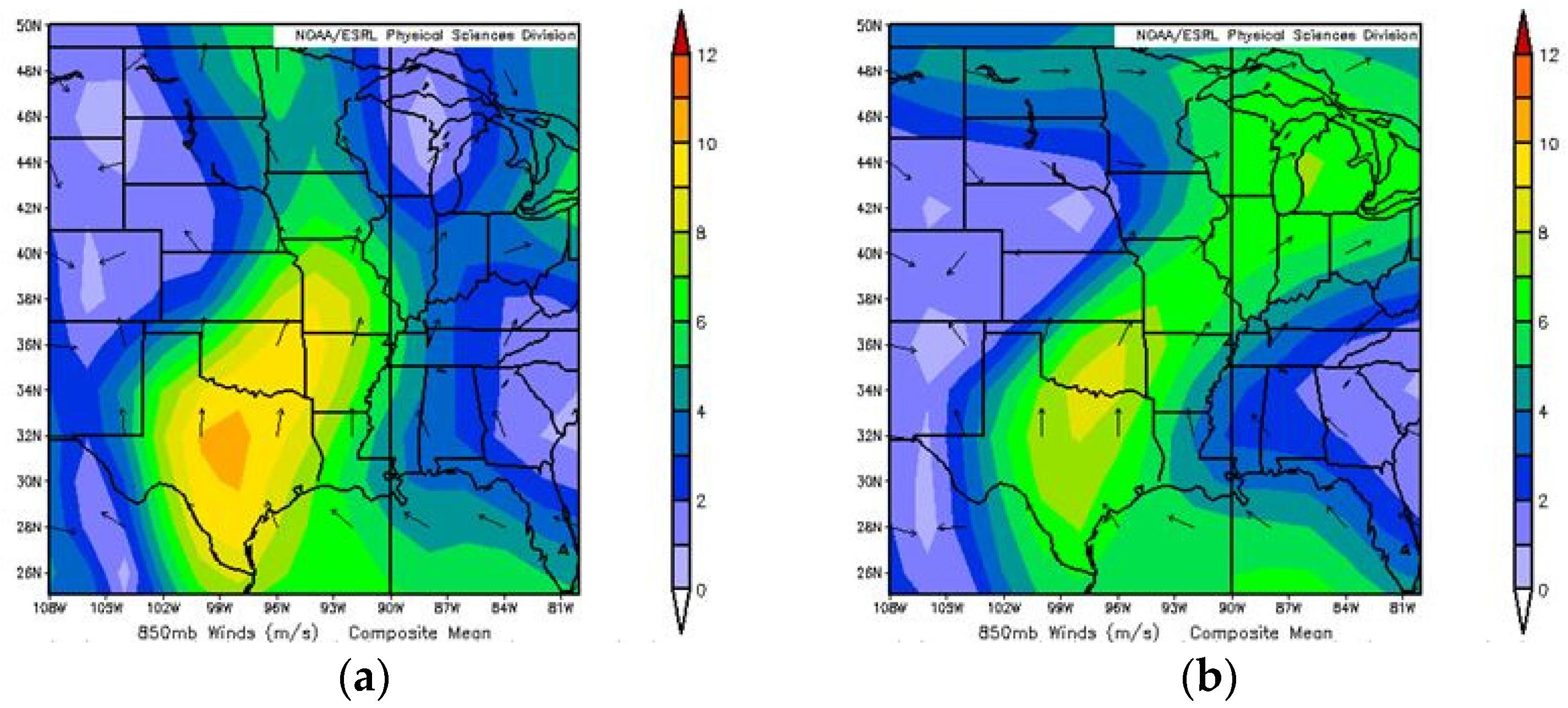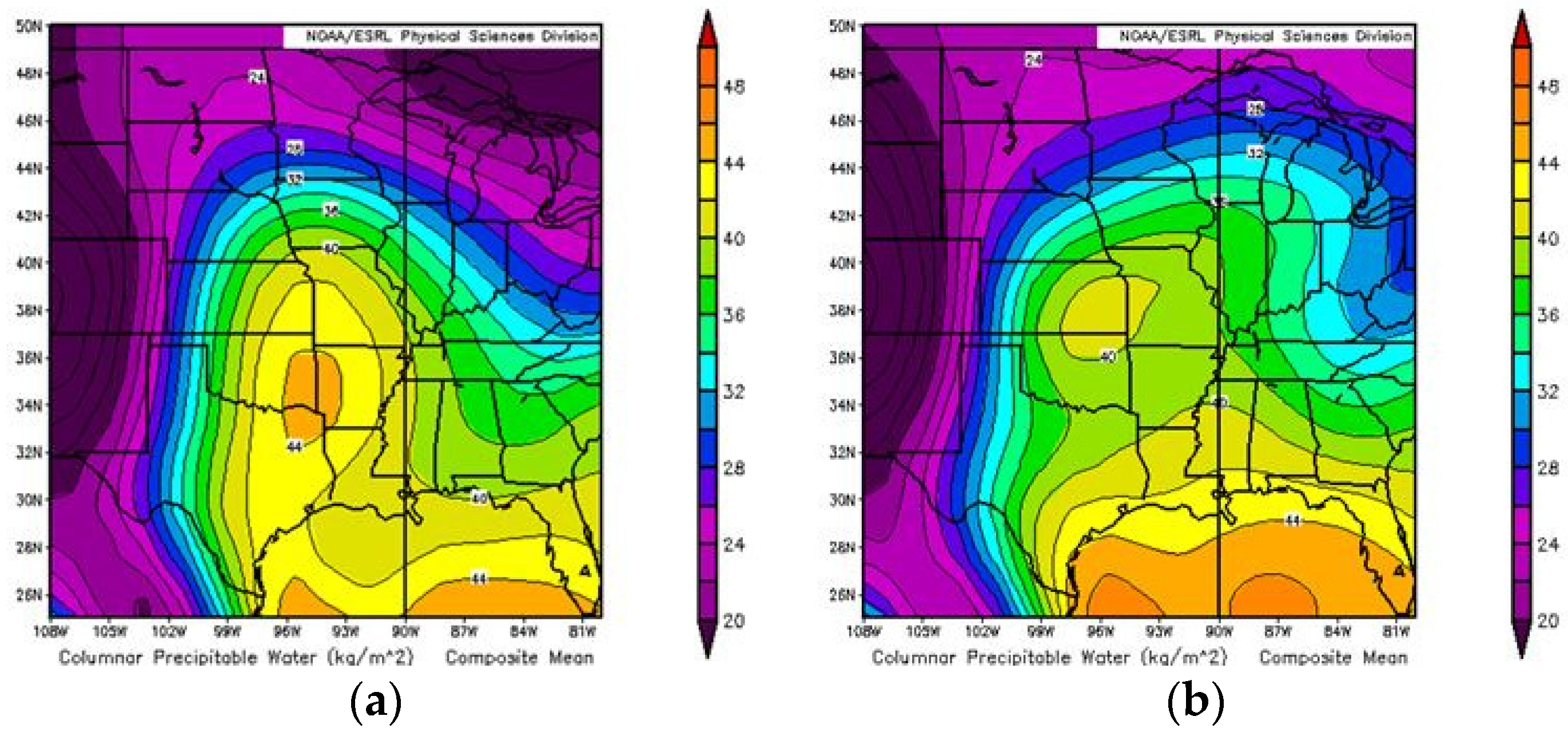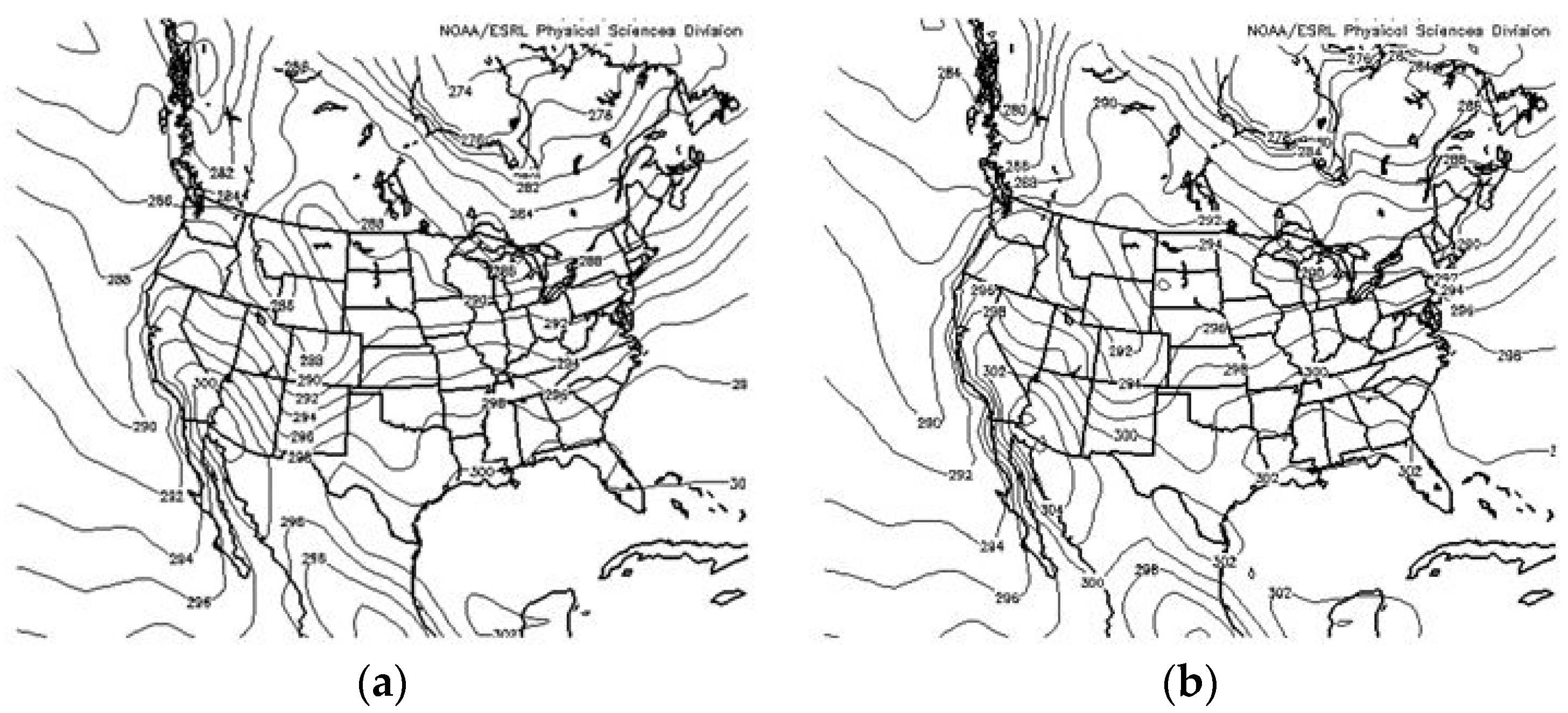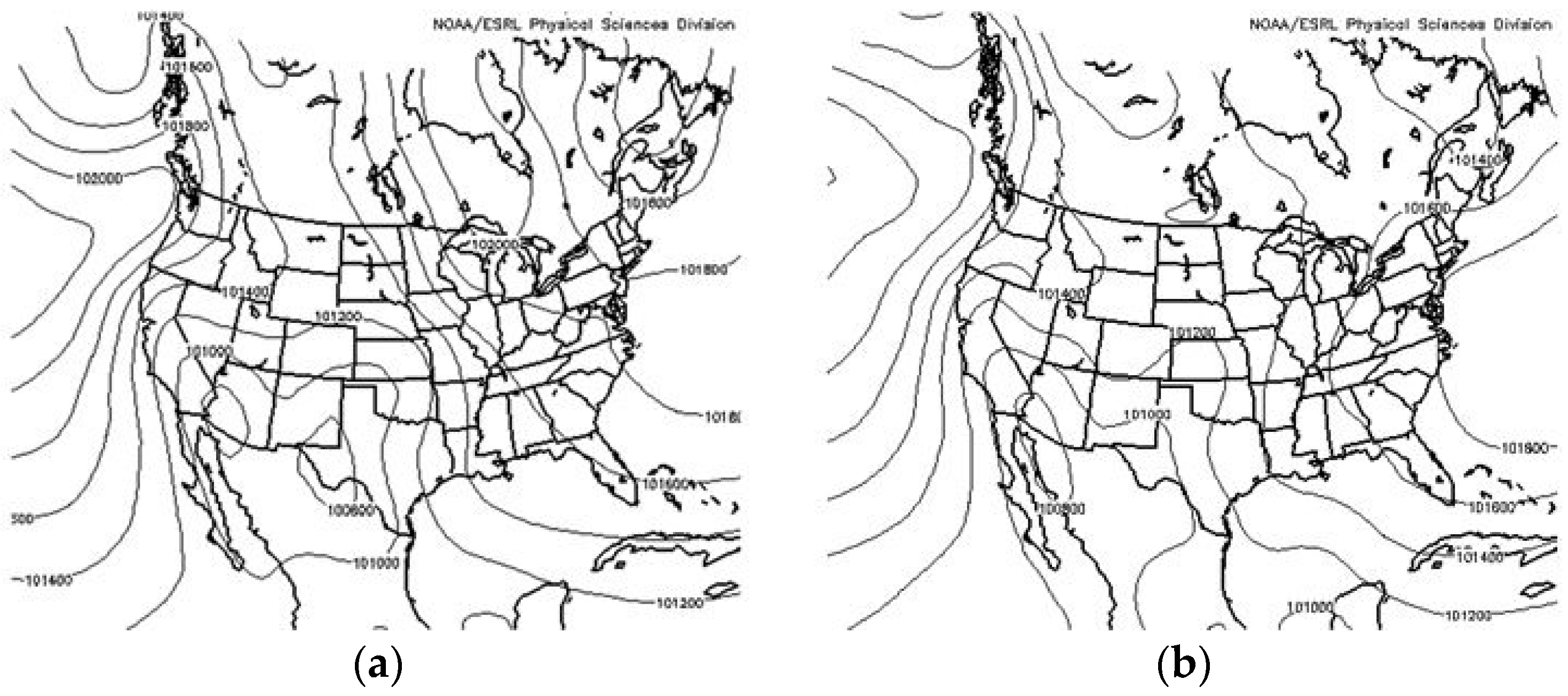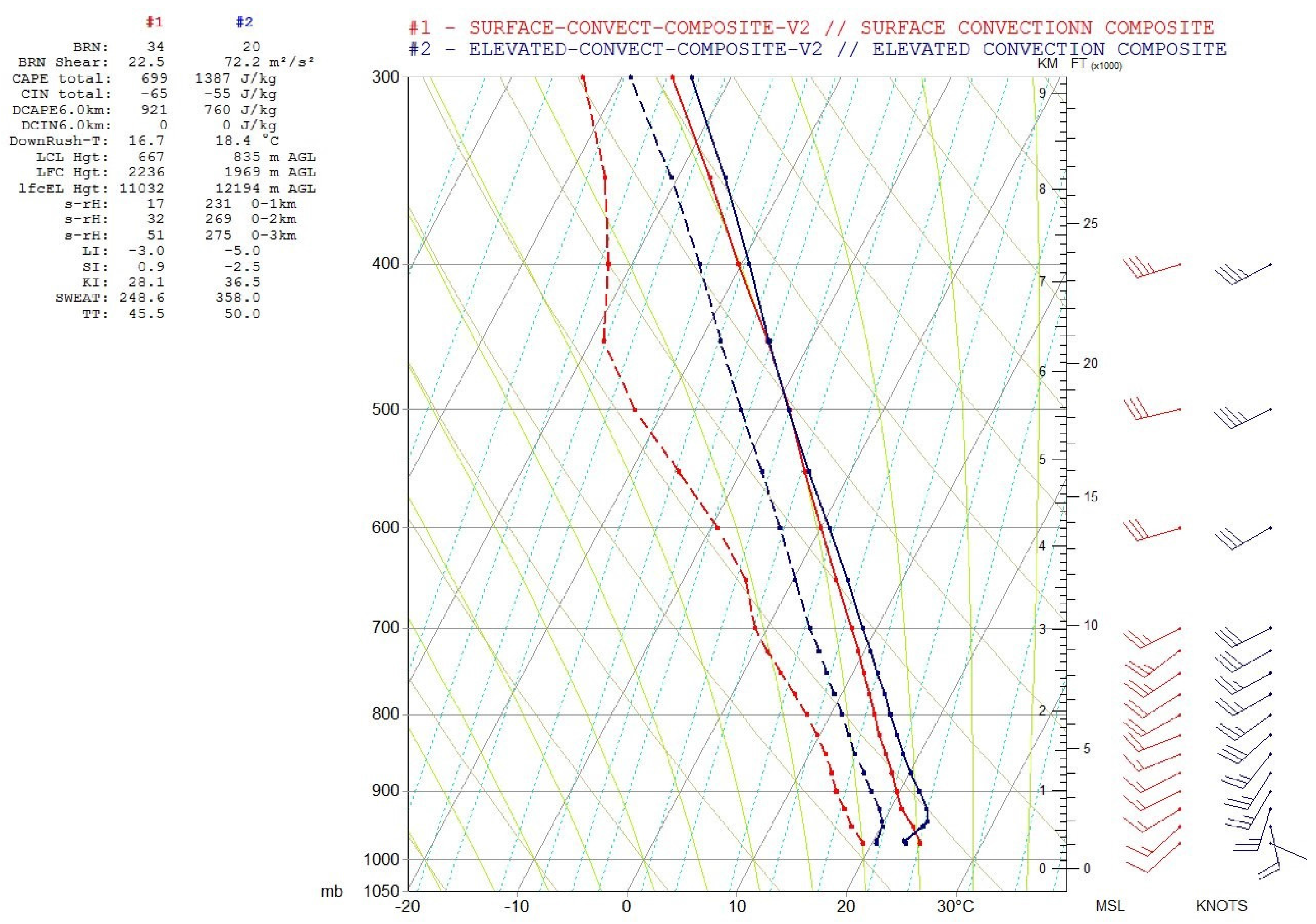2.1. Data
A direct comparison of surface-based and elevated convection in the context of lightning and heavy rain characteristics has yet to appear in the literature. We look first to the research on RLRs, which began in earnest with [
10]. A relationship had been established between lightning flashes and rainfall before [
10], but this work was the foundation for many studies to follow. The work of [
17] conducted a RLR study on the storm scale, analyzing 22 thunderstorms over Florida. The median RLR, which expressed the convective rainfall volume per CG lightning flash, for the 22 storms was 4.3 × 10
7 kg·fl
−1. An important conclusion of the study was that the RLR varies with convective regime. They [
17] also concluded that high lightning frequencies led to lower RLR values. If RLR values remain high, along with elevated lightning flashes, then the corresponding rainfall would need to increase as well. This could be used as a tool in the short-term prediction of flash floods and in the hydrological analyses of the spatial distribution of rainfall in regions where radar coverage is poor.
In addition, Peterson [
11] took a different approach to analyzing the RLRs. They completed a climatology of RLRs for the Continental United States (CONUS). They broke the USA into various regions of similar geography. They also computed the RLR values using a time period of one month. They found an average RLR value for the country to be 1 × 10
8 kg·fl
−1. They [
11] also stated that results seemed to be highly dependent on weather regime and geographic regime. This suggestion was taken into consideration when cases were selected for the current study. However, rather than focus on weather regime, differences in mesoscale environment were of particular interest here. Only cases that had a surface based thunderstorm and elevated thunderstorm events occurring over a similar geographic area (central United States), during a similar temporal timeframe (within 30 days), were used for this study. This study would fall into the “Mid-Continent” geographic region used by [
11], which both include Missouri. Both [
11] and [
17] concluded that convective regimes played a large role in the distribution of RLRs. The idea of differing convective regimes is an important one, and impacts maximum and mean rainfall amounts between elevated and surface-based thunderstorms. It should be noted that this study focuses on the mesoscale convective environment and not the regime.
Looking more closely at lightning characteristics, Fuquay [
18] conducted research describing positive CG lightning of 48 thunderstorm days over three consecutive summers. He found by averaging CG lightning over three years that 3% of the ground flashes were positive flashes. The data [
18] compiled were ambient electric field and electric field change. The study conducted for this paper found differences between elevated and surface based thunderstorms in positive CG lightning flash percentages using data from the National Lightning Detection Network (NLDN).
Elevated convection is also a known flash flood threat as stated by [
4], and was defined by [
1] as a storm that is isolated from surface diabatic effects and found above a frontal inversion. The studies of [
1,
2] defined an elevated thunderstorm via the following selection criteria based on observations from stations reporting a thunderstorm: (1) the observation must lie on the cold side of an analyzed front that shows a clear contrast in temperature, dew point, and wind; (2) the station’s wind, temperature, and dew point must be qualitatively similar to the immediately surrounding values; and (3) the surface air on the warm side of the analyzed front must have a higher equivalent potential temperature (θ
e) than the air on the cold side of the front. Similar criteria were also used by [
3,
4,
5,
19,
20] for studies involving elevated thunderstorms and will be used for this study as well.
The work of [
3] focused on elevated mesoscale convective systems (MCS), highlighting the synoptic regimes favorable for elevated MCS and episodes of heavy rain and elevated thunderstorms. This was also the theme of [
4]. The elevated thunderstorm cases occurred in synoptically favored conditions, i.e., synoptic regimes with a well-defined thermal inversion, though most occurred with boundaries (cold fronts, warms fronts and stationary fronts), which led to a wide area of heavy rainfall. The surface based thunderstorms that produces a widespread area of heavy rainfall occurred in broad synoptic conditions, similar to what is presented in [
3,
4] (ample moisture, lift, and instability, minus the frontal boundary). However, the surface based cases that had smaller areas of heavy rainfall did not occur over a frontal zone, or in synoptically favorable conditions. These storms often were slow moving and that was a significant cause for the heavy rainfall, not simply an atmosphere primed for heavy rainfall through moisture and instability. Then [
20] also touched on the idea of favorable synoptic conditions leading to widespread heavy precipitation, however that study also included cold-season precipitation. None of the studies above make any comparison to surface based thunderstorms, but do highlight regimes that are favorable for elevated thunderstorms. Simply put, elevated convection tends to occur in environments with greater large scale organization for moisture and lift, with a thermal boundary (often a front with an inversion): surface based convection can thrive in synoptically more marginal conditions, without an inversion.
Additionally, McCoy [
5] investigated over 250 cases of elevated thunderstorms over the central CONUS, which produced composites of conditions that were found just prior to elevated convection. This work proved useful as they provided a list of elevated cases in the time frame of this study. These cases were confirmed using similar methods in [
1,
2]. The main difference between the two regimes was the presence or absence of an inversion often below the 850-hPa level.
2.2. Methods
For comparison, statistics were calculated separately for each thunderstorm type (both within the heavy rain area): RLR within the heavy rain area, the extent of the heavy rainfall area, cloud-to-ground (CG) lightning flashes, CG lightning per hour, positive CG flashes, positive CG flashed per hour, percentage of positive CG flashes within the heavy rainfall area, and maximum and mean rainfall amounts within the heavy rain area were calculated for each category of thunderstorm. The locations of the cases were confined to the central CONUS, specifically areas in or near Missouri.
Cases were selected for investigation with the intention of minimizing bias. Elevated thunderstorm cases were selected for dates between May and September during the years 2007 to 2010. Cases identified in [
5] were used. Surface based thunderstorms were only selected if they occurred during the same months and year as the elevated thunderstorm case. This does not guarantee the sets of thunderstorms occurred in a similar weather regime (as in [
11]), but rather shows that both elevated and surface based thunderstorms with heavy rainfall are possible within the warm season near a given date. If more than one surface based thunderstorm case occurred in a month, the case closest to the elevated case date was used. This allowed for a balanced dataset with each thunderstorm type represented equally. This also ensured that elevated and surface based thunderstorms occurred during a similar timeframe. However, this limited the number of each type of case to eight for a total of 16 cases. Again, mesoscale environment was examined, not regime. Composites of 18 elevated and 18 surface based convective reanalysis environments are discussed further in
Section 3.
The goal of this study is to compare the two populations of convective storms based on the extent of the heavy rainfall areas (>50.8 mm per 24 h) for surface based and elevated convection. The heavy rainfall area is being used as the investigation area for a few reasons: (1) it provides a common threshold for both sets of thunderstorms; (2) it focuses on the most dangerous portion of the storm (from a flooding and lightning perspective); (3) the size of the area itself is telling about the thunderstorm complexes; and (4) numerous studies [
11,
17,
21] link heavy convective rainfall and CG lightning flashes.
The data used for this project came from a variety of sources. The lightning data were obtained from the National Lightning Detection Network (NLDN) via Vaisala, for the period 2007–2011. As noted by [
17], the NLDN has a detection efficiency of 85%. This is much better than satellite sources, which vary greatly between day and night and, according to [
22], can have detection efficiency of ~70%. The lightning data supply a latitude and longitude and whether the flash was CG or cloud-to-cloud (or cloud-to-air). Lightning flash rates of flashes per hour over the heavy rainfall area were used. This was calculated by dividing the total number of CG strikes within the heavy rainfall area and dividing by lightning start time and end time within the same area. Hourly flashes rates were selected as these cases are focused on the heavy rain foot print, which falls into the mesoscale temporal and spatial scale. Hourly observations are appropriate for investigating mesoscale phenomena per [
23]. In addition, Reap [
24] showed CG lightning flashes broken into hour bins. Radar data in Level II format was acquired through the National Climate Data Center (NCDC). The precipitation data were acquired through the National Weather Service’s (NWS) Advanced Hydrologic Prediction Service. These data are radar-estimated daily (24 h) liquid precipitation accumulation and comes as a point dataset. This dataset is rain gauge augmented as well as satellite augmented, and it treats the rain gauge values as absolute (ground) truth-values. Because the rain gauge network is neither uniform nor complete in coverage, gaps are filled in with radar-estimated precipitation accumulations. If radar data are not available, then satellite data are used to fill in the gaps. The daily data begin at 12:00 UTC and end at 11:59 UTC the day of recording. For example, the daily rainfall amounts recorded for 4 April are data from 12:00 UTC 3 April to 11:59 UTC 4 April.
In order to be selected, elevated convection events had to meet the following criteria:
- (1)
each event day (12:00–11:59 UTC) had to have an area of an average convective rainfall accumulation depth (>50.8 mm·day−1);
- (2)
the majority of precipitation had to occur as convective rainfall (radar reflectivity ≥40 dBZ);
- (3)
CG lightning flashes had to occur over the heavy rain area;
- (4)
each thunderstorm type had to occur during a similar timeframe and over a similar geographical location; and
- (5)
had to meet the selection criteria of [
1], and/or exist above a significant thermal inversion [
5].
The radar reflectivity threshold of ≥40 dBZ was selected because Xu [
22] showed that convective rainfall was associated with values of ≥40 dBZ. Radar data were inspected for each potential case to ensure convective rainfall occurred. Precipitation data were then plotted for the central CONUS. Because the precipitation is a point dataset, interpolation using the Aeronautical Reconnaissance Coverage Geographical Information System (ArcGIS) ArcMAP software package (Version 10.1, ESRI, New York, NY, USA) licensed to the University of Missouri, via kriging, was conducted to highlight areas that had an average precipitation accumulation depth ≥50.8 mm·day
−1.
Figure 2 shows the results of the kriging interpolation of the point file acquired from the NWS Advanced Hydrologic Prediction Service. Kriging was shown to be the best interpolation method when using radar-derived precipitation accumulation [
25]. Through a series of tests on the data, it was found that ordinary kriging, using a spherical semivariogram model, with a variable search radius of 10 would yield the best results. This conserved both maxima and minima of accumulated precipitation. The kriging process revealed areas of >50.8 mm·day
−1 (referred to as the heavy rain areas), as seen in
Figure 3. These areas of heavy rain were traced from the precipitation interpolation and a new layer was created. Lightning and point rainfall data were then clipped to these heavy rain area layers. This clipping revealed total CG lightning flashes within the heavy rain area as well the maximum and average rainfall within the heavy rain area. CG flashes were then sorted to determine positive and negative flash counts. This allowed percentages of positive flashes to be calculated.
Vertical profiles from the North American Regional Reanalysis (NARR) were inspected to confirm whether storms were elevated or surface based, which used by [
5] for initial case identification. The latitude and longitude of the heaviest rainfall location was used to determine sounding location. The nearest time step (to the hour) prior to precipitation occurring at that location was used for the soundings. In a further effort to minimize bias between the two groups of thunderstorms, sounding parameters were calculated, including the depth of the warm cloud layer, for both elevated and surface based convection. This was done for both individual soundings, as well as their composites as suggested by [
26] and employed by [
27]. In addition, the two sets were examined for the dominant mode of convection. Here, the NARR profiles and Level II radar data were employed, respectively, to help establish commonality between the two groups.
RLRs for both sets of thunderstorms were also calculated, using the heavy rain area (km2), total event period (12:00 UTC to 12:00 UTC) CG lightning flashes within the heavy rainfall area, and average accumulated rainfall within the heavy rainfall area. Next, the precipitation accumulation average depth was established. While the kriging highlighted areas of interest, it did not provide a mean precipitation depth. The mean rainfall within the heavy rain area point precipitation file was used to find the mean depth.
Finally, the Mann–Whitney nonparametric statistical approach was used to test for differences between surface based thunderstorms and elevated thunderstorms in the following categories; RLR within the heavy rain area, the extent of the heavy rainfall area, CG lightning flashes, positive CG flashes, and percentage of positive strikes in the heavy rainfall area, maximum and mean rainfall amounts within the heavy rain area. The Mann–Whitney test was used as opposed to a two-sample
t-test because the variables tested are not normally distributed. This was done in a similar manner by [
27] for proximity soundings of thunder snow and non-thundering snow events in the central United States. All surface based thunderstorm cases (
n = 8) were considered one set of data and the elevated thunderstorm cases (
n = 8) were considered the other set of data for the Mann–Whitney tests. Given the low number of cases, the null hypothesis was rejected if
p > 0.10. A summary of all the
p-values can be found in
Table 1.
